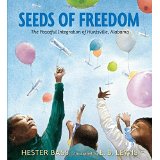 Author Hester Bass and illustrator E. B. Lewis, team up again for a nonfiction picture book after considerable acclaim for The Secret World of Walter Anderson. Seeds of Freedom portrays the peaceful integration of Huntsville, Alabama.
Author Hester Bass and illustrator E. B. Lewis, team up again for a nonfiction picture book after considerable acclaim for The Secret World of Walter Anderson. Seeds of Freedom portrays the peaceful integration of Huntsville, Alabama.
It begins in January 1962 with a clear empathetic depiction of segregation for young children who thankfully know about it only from hearsay if at all. Hester juxtaposes “just the way it is” with her “seeds of freedom.” Showing peaceful methods of change encouraged by both the white and black leaders, Hester does not sugarcoat the difficulties nor imply a happily ever after ending, and she does not omit the politicians who add to the unrest rather than help when they come to Huntsville. She is clear that the economics of a community dependent on the federal space program and the “Blue Jean Sunday” bring financial pressure to find a better way for blacks and whites to live together. She includes a “reverse integration” of white students into a black private school in Huntsville the same week the public school is integrated.
Seeds of Freedom rings true, especially for those who had similar experiences during this era. Integration was difficult without being brutal in many Southern communities. The author’s note at the end gives much that can be used by a parent or teacher in discussion with the child reader both from the aspect of how things were and hope for how things can be better in the future. A careful wordsmith paired with an insightful illustrator, the Bass and Lewis team brings the era and its people to life. I highly recommend the book for its ability to make history live for young children by seeing those who experienced it.
As Hester signed in the book I bought for my grandsons – “To Peace and Freedom.”